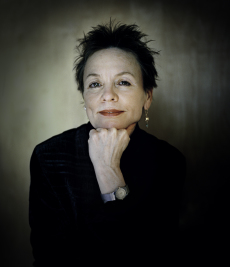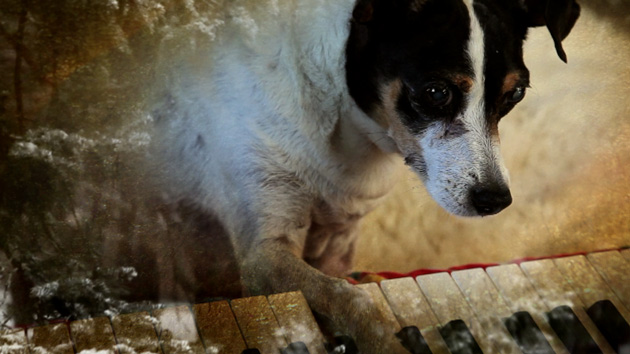
One of the most distinctive films on the festival circuit this year was Heart of a Dog, a 75-minute documentary in which performance artist and musician Laurie Anderson remembers the life and death of her beloved rat terrier, Lolabelle. The film was commissioned by the French-German TV channel Arte, which had been asking artists to make short personal essay films that tended to be very simple, running about 20 minutes in length. Anderson's outgrew that model — when she turned it in, she says, it was two years too late and about an hour too long.
Her finished piece combined snippets of animation, her own paintings, digitally processed 8mm footage, dog's-eye POV shots of Manhattan's West Village, and spoken-word narration considering everything from the 9/11 attacks and the surveillance state to Eastern philosophy and that time she broke her back at the swimming pool. Her late husband Lou Reed appears only very briefly, but his presence (and absence) are evident throughout. The resulting film premiered in September at the Telluride Film Festival before moving on to play festivals in Venice, Toronto, New York and Chicago. Acquired by Abramorama and HBO Documentary Films, it's now screening around North America in limited release before playing next year on HBO.

Anderson visited the Jacob Burns Film Center in Pleasantville, New York, this week for a showing of the film and an on-stage Q&A with director Jonathan Demme, who first worked with her on his 1986 film Something Wild. The conversation ranged from the question of whether Lolabelle actually carried a camera ("She did shoot some things early, but we didn't use anything that she shot because they tended to be just crotch shots," Anderson quipped) to the absence of Anderson's father from any of the assembled family home movies ("he's where all the dads are — he's the DP," she said), but Anderson kept returning to comments about the simplicity of the film. (As she told Film Comment earlier this year, "My little movie was in the Venice Film Festival, and it was probably less than lunch budget for one day of any of the other films.") Below is the film's trailer, followed by some key excerpts from the conversation as they apply to personal filmmaking.
1.) Filmmaking technology can be simple. "A lot of this was done with iPhones and [Canon] 5D cameras — very small cameras in a very casual way," Anderson said. Viewers of an early cut of the film were taken by the sound of Anderson's voiceover against a silent backdrop and urged her not to add any music but, as a musician, she felt that would be too minimalist an approach. Co-producer Dan Janvey suggested she create a soundtrack using only strings. "I began to realize how many of my favorite movies are just strings," she recalled. "They have no beat. I wanted to make something so that your eye would be very rhythmic. As soon as you have beats, it relates to a cut. So I wanted the eye to be very rhythmic and free, so that's how the so-called score was made. Effectively, it was just me looking at my laptop playing violin and adding some songs. Done in, again, a very casual way. Any time something seemed too busy, I would just make it simple."
2.) Make your instruments — whether audio or visual — your own. Anderson described her preferred five-string violin, which has gone through seven different iterations with instrument designer Ned Steinberger. He is known for designing bass instruments, and helped ensure that she could play low octaves on her violin. And she used special production techniques to help the audience hear what she heard while playing. "When your head is right next to an instrument, you hear all this crunching and you hear harmonics and you hear all sorts of overtones," she explained. "By the time that gets to an audience, you don't hear that. All of that is gone. And I love the grittiness of that kind of sound, so the filters I designed for the software pulls those things up off the noise floor and makes it part of the music."

3.) Don't be afraid to mix your media. In addition to camera-shot footage, Heart of a Dog also includes some animation, and paintings Anderson made of Lolabelle. She says the process is not so different. "Those were really big paintings — they were like 14 by 14 feet and doing them was a really wonderful thing for me at the time because I wanted to think about [Lolabelle]," she said. "In a certain way, many of these things are a similar process. For example, drawing something like that, for me, is very much like playing the violin. It's the same gesture, the same way of making something. I ask all the same questions about a piece of music and a painting: Is it wild enough? Is it complex enough? What kind of energy does it have? It doesn't seem like different media to me. It seems like the same way of working."
4.) Be open to using footage in ways you hadn't planned. One of Anderson's many subjects in Heart of a Dog are phosphenes, elements of vision that aren't triggered by light entering the eye — if you're "seeing stars," those shapes and lights are phosphenes. You might expect Anderson to use animation or visual effects techniques to approximate the phenomenon, but in response to a question from the audience, she revealed her secret: drones. "Those phosphenes are represented, in this case, by drones," she said. "I shot a lot of this film with drones, and I hardly used any of that footage. It's amazing that there are no laws about drones. You can just drive your drones around buildings and look in. It's horrible! [Laughter.] But that footage was a drone looking at its own shadow in a studio that had a lot of intense light and smoke. So you're seeing the rotating blades of the drone, and then I kind of threw it out of focus. It did remind me of these very organic shapes that are the phosphenes."
5.) Even when it's all about you, it's not all about you. Anderson was careful to note at the close of the discussion that she never intended Heart of a Dog to focus the audience's interest on her own life and experiences. Instead, it was meant as a catalyst for the viewer's own thoughts. "This is not a film about getting to know me or my life," she said. "This is a film that is made for people to jump into with their imaginations. That's why it's made of questions. That's why it ends with questions. It's about where we're going, and what people do with language." She described a scene in the movie about a man who lived up in the trees in Anderson's Midwestern home town, pretending he worked for the telephone company. The locals played along — he wasn't hurting anyone, after all. Anderson found that to be an evocative portrait of small town life, and she wanted to put it in the film without actually shooting footage of a man in a tree. "It's [about] empathy for somebody who is a little different," she notes. "But all you see is telephone poles and telephone wires and blank sky. So this is a radio play in certain ways. It's a work of imagination. I tried to make it as open-ended as I could, to make it about your own life. It's a fill-in-the-blanks sort of movie."

Topics: Blog Films and Filmmakers laurie anderson
Did you enjoy this article? Sign up to receive the StudioDaily Fix eletter containing the latest stories, including news, videos, interviews, reviews and more.
